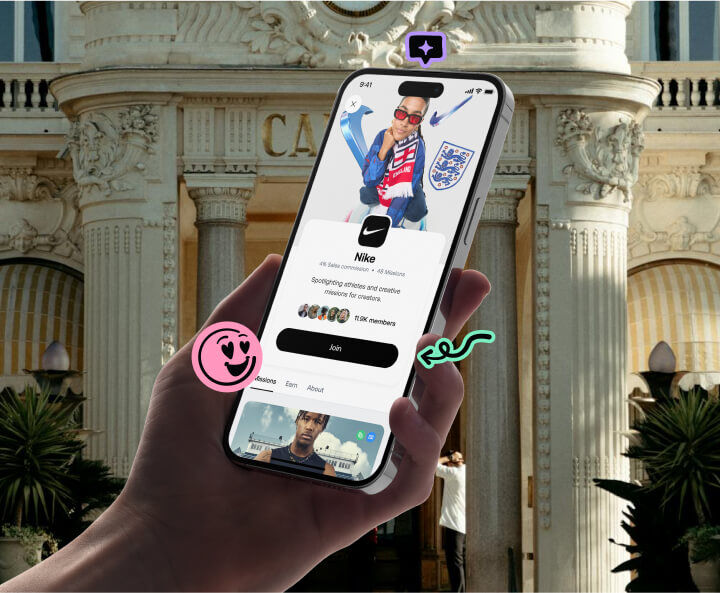Are you thinking about teaming up with social media influencers to get your brand in front of more eyes? It can be an amazing way to boost your brand’s visibility, engagement, and sales. But, like anything, there are some things you’ve got to watch out for. Knowing both the influencer marketing pros and cons will help you craft an influencer strategy that gets you to your marketing goals!
10 influencer marketing pros & cons social media managers should know
 10 influencer marketing pros & cons social media managers should know">
10 influencer marketing pros & cons social media managers should know">
Amy Roberts
Content Marketing Manager

The rise of social
media creators
The power of social media is undeniable. Platforms like Instagram, Facebook, X, and TikTok connect brands with their audiences directly. Collaborating with creators takes this connection to the next level because word-of-mouth marketing is still one of the best ways to promote a business.
Creators share authentic content and engage with their followers – that’s how they build their own personal brands. Putting your product in their hands and making them brand ambassadors can help your business reach new audiences and build deeper connections. In fact:
-
69% of consumers trust recommendations from creators, friends, and family over information directly from brands.
-
81% of consumers say social media posts from creators, friends, or family drove interest in products or services.
-
Social media creator campaigns earn an average of $5.78 for every dollar spent.
At Club, we’ve seen how creators can cultivate communities, build loyalty, and drive sales. But success depends on setting clear goals, weighing both the pros and cons of using influencers, and choosing the right creators.

Maycon Marmo
Types of social
media influencers
Influencers are often categorised by their follower numbers:
- Mega influencers have over one million followers.
- Macro influencers have between 100,000 and one million followers.
- Micro influencers have between 1,000 and 100,000 followers.
- Nano influencers have less than 1,000 followers.
While mega and macro influencers have the most followers, don’t skip out on creators with smaller audiences! Their rates are less, they’re often seen as more authentic, and they typically get more engagement.
Influencers come from every niche, from travel and food to tech and fitness. However, simply sending your product to a creator isn’t enough. You need a clear, measurable goal to guide your collaboration.

Influencers understand their niche audiences, making them ideal for brands looking to scale fast. By collaborating with creators in your industry, you can access a highly engaged audience without coming across as inauthentic (remember: authenticity always!).
Goals of influencer marketing
What are you hoping to achieve by working with creators and building an ambassador programme? Your goals will influence the type of creator you collaborate with, the content they produce, and the calls-to-action (CTA) they use.
Common goals include:
- Expanding reach: Influencers can introduce your product or service to new audiences.
- Driving engagement: They can foster meaningful interactions between your brand and customers.
- Building brand trust: Followers trust their opinions, which can influence buying decisions.
- Increasing traffic: Influencers can direct traffic to your social profiles and website, thereby increasing followers.
- Boosting sales: With the right approach, influencer marketing can significantly impact your bottom line.
Now, let’s get into influencer marketing pros and cons.

Vlada Karpovich
5 pros of working with social media influencers
1. Fast-tracked growth with super engaged audiences that will take action
Influencers understand their niche audiences, making them ideal for brands looking to scale fast. By collaborating with creators in your industry, you can access a highly engaged audience without coming across as inauthentic (remember: authenticity always!).
An influencer agency tested the difference in response with traditional ads and influencer content, and what they found was incredible! Karyn Spencer, Global Chief Marketing Officer of Whalar, told the Future Proof podcast about this study. They strapped respondents in neurological readers and exposed them to traditional television ads and influencer ads. The brains of humans light up when they are looking at influencer ads compared to traditional branded TV ads. “They are registering 277% more emotionally intense and 87% more memorable – influencer ads versus brand ads. Creativity drives emotion in the brain, emotion drives memory, memory drives recall, and recall drives sales.”
Content creators make high-quality posts that they know are going to grab the attention of their audience as well as the algorithm of the platform they’re on. High-quality content + an engaged audience that trusts what the influencer says = rapid growth for your brand!

SHVETS
2. Increased brand visibility and awareness across platforms
Influencers are experts at introducing their followers to new brands. They can boost your visibility and brand awareness on platforms like Facebook, Instagram and TikTok by using content formats like stories, reels, live streams, and cross-collaborations.
Social media platforms have massive audiences to tap into! Facebook boasts nearly 3 billion active users, Instagram has 2 billion people scrolling on the app, and TikTok has over 1 billion monthly users all around the world.
There are so many ways that influencers can add your brand into purchase-making decisions, such as running giveaways, doing brand collaborations with other content creators, and showing how your products or services work.
3. More impactful user-generated content (UGC)
UGC is original, brand-specific content created by customers. This type of content is highly beneficial for businesses, as it reduces the pressure on in-house resources. UGC comes in many forms, from testimonials and reviews to blogs, photos and videos.
With so many ads and promotions bombarding consumers every day, UGC is a way to stand out. UGC is a form of earned media that can save you a lot of money when compared to paid media.
UGC can also come in the form of paid media for example, if you decide to boost organic UGC posts from your community or if you collaborate with influencers to create IGC-style content for a specific campaign. It still has the same effect of impactful social proof.
Often, if experienced content creators have an affinity to your brand, they’ll produce engaging, high-quality content that enhances the presence of your brand without you doing the actual work.

Tolgraw Photography
4. Increased brand trust through authentic content
Brand trust is the confidence that clients feel about your business’s ability to deliver on what it promises, and it is essential in growing a brand.
“Authentic” may seem like an overused buzzword as of late, but it’s a vital part of successful marketing. Sprout Social found that about half of all consumers say that authenticity is a top quality they look for in the creators they engage with.
Creators genuinely enjoying your products or services in their content are an extremely effective way to promote confidence in potential buyers in an authentic, relatable way.
5. Access to new markets and a broader audience base
An influencer marketing strategy offers a powerful way to tap into new demographics and expand your brand’s reach quickly. By collaborating with creators who have established followings in your target market, you can introduce your products or services to fresh audiences who may not have encountered your brand otherwise.
Creators can bring valuable insights into the preferences and interests of their communities, making them ideal partners for brands looking to make a meaningful entry into new markets. This tailored approach not only helps you break into a specific market but also allows you to build trust and credibility with audiences who are already engaged and receptive to the creator's recommendations.
But, there are benefits and challenges of influencer marketing. Let’s get into the disadvantages.

Alena Shekhovtsova
5 cons of working with social media influencers
1. Overwhelming growth that is hard to control
You want to experience a surge in demand for your products or services; but, are you ready to handle the increase in numbers?
For example, you want to promote a hydrating moisturiser perfect for the winter months. An influencer tries your product, loves it and starts posting about it to her 800k audience with a discount code.
Do you have enough stock to fill the potential orders that come through? Is your e-commerce store easy to use for online shoppers? Are you positive that the discount code works? And, if shipping fast enough to get your product to buyers during the winter months?
Rapid growth can be challenging if your brand isn’t ready for it. If an influencer campaign leads to a surge in demand, you’ll need systems in place to handle it to avoid disappointing new customers.

TONL Imagery
2. High price tags when working with popular influencers
When collaborating with established macro or mega influencers, you may encounter substantial fees that can stretch or even exceed your marketing budget. These creators typically have vast followings and extensive reach, which often comes at a premium cost.
According to Influencer Marketing Hub, working with mega influencers on TikTok can set brands back around $2,500 per post. Macro influencers charge around $1,250 to $2,500 per post. For smaller brands or those working within tighter financial constraints, these high price tags can limit the feasibility of engaging with such influencers.
However, micro or nano creators present a cost-effective alternative, with micro influencers charging around $25 to $125 per post and nano influencers $5 to $25. Although they have smaller followings, their audiences are often highly engaged and niche-specific, which can offer more targeted and authentic brand connections.
By choosing micro or nano creators, brands can benefit from meaningful audience interactions without the hefty investment, making this an attractive option for maximising impact within a budget.
Micro and nano influencers are also particularly successful at marketing local businesses like florists or coffee shops.
3. Potential for mismatched content that’s not right for your brand style
If a creator’s style doesn’t align with your brand identity, it could affect your reputation and the perception among your audience. To avoid this, review their past work to find content creators who are aligned with your brand values.
By selecting creators who naturally resonate with your brand’s core values and visual identity, you can ensure that their content feels authentic and enhances your brand image rather than detracting from it.

Gabriella Csapo
4. Your brand’s reputation is tied to the creator’s actions
When you collaborate with an influencer, your brand becomes associated with their personal brand, which means that any controversies or negative publicity they face could impact you as well.
If a creator shares a polarising political view, takes a controversial stance on cultural issues, or becomes involved in a scandal, it can lead to backlash not just against them, but also against any brands they represent.
This “guilty by association” effect can be super damaging, as followers will start to question your brand’s values and intentions which leads to unfollows, negative comments and a decline in customer trust.
That’s why it’s so important to carefully vet creators before partnering with them. Look for influencers whose values align with your brand and who have a positive track record. By choosing creators who genuinely reflect your brand’s identity, you can lessen the chance of your brand’s name getting dragged through the mud.
5. Uncertainty over real follower numbers
Fake followers are still common on social media, which can make it hard to gauge a creator’s true reach and influence. Look beyond follower counts and consider engagement metrics to assess a creator’s impact.
Prioritising quality over quantity when it comes to followers will help you partner with creators who have really active, authentic communities that can drive meaningful results for your brand.
Thankfully there are now many fake follower tools you can use to audit an influencer's profile and audience before you decide to work with them.

Bello Olamide
Final thoughts
There are both advantages and disadvantages of influencer marketing. But, collaborating with the right social media creators can be a powerful way to elevate your brand. By weighing up the pros and cons, you can set yourself up for successful partnerships and grow an engaged and loyal brand community.

Azra Tuba Demir
Keep up with the
latest from Club
Subscribe to our blog and get free ecommerce tips, inspiration, and resources delivered directly to your inbox.

Get more inspiration

Marketing brand ambassadors: What is ambassador marketing and why it works

By Amy Roberts
9 min read

8 e-commerce marketing agencies for max growth in 2025

By Amy Roberts
3 min read

7 easy steps to create your best brand ambassador marketing campaign

By Amy Roberts
9 min read
Automate your community marketing in 60 seconds.
Automate your community marketing in 60 seconds.
Copyright ⓒ Club. All rights reserved
 Book a demo
Book a demo

